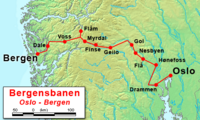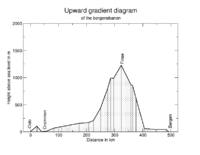Bergensbanen
| Bergensbanen | |
| 250px | |
|---|---|
| The Bergensbanen on the Hardangervidda near Finse. The track shown here is an abandoned section of the line, which now runs through a tunnel | |
| Info | |
| Type | Railway |
| System | Norwegain railway |
| Start station | Hønefoss |
| End station | Bergen |
| No. of stations | 17 |
| Operation | |
| Opened | 1909 |
| Owner | Jernbaneverket |
| Operator(s) | Norges Statsbaner CargoNet |
| Character | Express trains Freight trains |
| Rolling stock | BM 73 |
| Technical | |
| Line length | 372 km |
| No. of tracks | 1 |
| Gauge | 1,435 mm (4 ft 8½ in) |
| Electrified | 15 kV 16⅔ Hz AC |
| Highest elevation | 1222 m |
Bergensbanen is the railway between Bergen and Oslo in Norway. It is the highest mainline railway line in Europe and one of the most spectacular, crossing the Hardangervidda plateau at over 1200 meters (4000 feet) above sea level.
Contents
History
Bergen is the second largest city in Norway and, as early as 1870, proposals were raised for a railway to connect it to the capital. There were several possible routes for the line and it was not until 1894 that the final decision was made by the Storting, the Norwegian legislature. Only the first stretch of the line, from Voss to Taugevatn, was initially authorised, with the rest being authorised in 1898.
The construction of the line was exceptionally challenging. It had to be laid high above sea level, in a region without roads and with a climate that saw many feet of snow in the winter and temperatures far below freezing. Tunnels and cuttings had to be excavated through solid gneiss, with one tunnel alone - that at Gravhals - taking six years to build, mostly by hand.
The line from Voss to Myrdal was opened in the summer of 1906, with the full line opening for passenger traffic on 27 November 1909. King Haakon VII stated upon the opening of the Bergenbanen that this was the Norwegian engineering masterpiece of his generation. Readers of Norwegian Technology Weekly (Teknisk Ukeblad) voted the Bergensbanen the fifth greatest Norwegian engineering masterpiece of the 20th Century. Steam engines ran on the line until 1957 but in 1964 the line was converted to electric traction, at 15 kV 16⅔ Hz AC.
Line description
The overland route between Bergen and eastern Norway crosses the harsh and inhospitable Hardangervidda plateau, which stands between the western fjords and the interior.
The line runs for a total length of 493 km with 182 tunnels, totalling approximately 73 km. The longest single tunnel on the line is that at Finse, just over 13 km long. The line crosses 300 bridges spanning numerous rivers and streams. The highest station on the line (and the highest mainline station in Europe) is at Finse, 1222.2 meters above sea level. The line's highest point was Taugevatn near Finse, at 1300 meters, until Finsetunellen opened in 1993; it is now inside this tunnel, at 1237 meters. It takes a total of 6-7 hours to travel the full length of the line. The line has a maximum gradient of 1:46.5 on the Voss-Myrdal stretch. It is kept open all year round, although not without some difficulty due to the heavy snowfall experienced on the Hardangervidda; in 1967, railway workers had to clear 67 feet (20.4m) of snow from the line.
The railway is today a popular tourist attraction, as well as a busy intercity route. It provides an essential link to the Hardangervidda and is especially popular with hikers and cyclists. The old railway workers' road, the Rallarvegen (navvy road), runs alongside the line and can be cycled in a day; the Norwegian State Railway provides rental bicycles from depots at Finse and other points along the line. At Myrdal, a spectacular 20 km-long branch line, Flåmsbana, leads down to Flåm.
Proposed closures of the line
In 2002 the Norwegian National Rail Administration (Jernbaneverket) warned that lack of funding might lead to a closure of all long-distance passenger trains in Norway, including the Bergensbanen. Torild Skogsholm, the minister for transportation assured that it was not the government's policy to close railway lines.[1]
In 2004, the the Progress Party's spokesperson for transportation affairs, Kenneth Svendsen suggested closing down the railway line and replacing it with a highway between Bergen and Oslo. The rationale was that funding a better road instead of the railway would aid commerce and that the long distance bus companies were already offering cheaper tickets than the railway. Local politicians in the Labour Party and Conservative Party both rejected the proposal pointing out the better environmental performance of the railway and that the railway transports large volumes of freight. [2]
In 2006 Jernbaneverket cautioned that the railway line was in need of upgrades to improve speed. In particular, they urged more attention to building a direct line across Ringerike between Hønefoss and Oslo to cut about one and a half hours from the journey time, and that without it, the future of long-distance passenger service on the line may be brought into question.[3]
Bergensbanen stations
| Station name | Height above sea level (m) | Distance from Oslo (km) | Distance from Bergen (km) |
| Oslo | 2 | 0 | 493 |
| Asker | 104 | 24 | 469 |
| Drammen | 2 | 41 | 452 |
| Hokksund | 8 | 58 | 435 |
| Vikersund | 67 | 84 | 409 |
| Hønefoss | 96 | 112 | 381 |
| Flå | 155 | 174 | 319 |
| Nesbyen | 168 | 208 | 285 |
| Gol | 207 | 225 | 268 |
| Ål | 436 | 250 | 243 |
| Geilo | 794 | 275 | 218 |
| Ustaoset | 990 | 286 | 207 |
| Haugastøl | 988 | 297 | 196 |
| Finse | 1222 | 324 | 169 |
| Hallingskeid | 1110 | 345 | 148 |
| Myrdal | 867 | 358 | 135 |
| Upsete | 850 | 364 | 129 |
| Mjølfjell | 627 | 376 | 117 |
| Voss | 57 | 407 | 86 |
| Dale | 43 | 447 | 46 |
| Arna | 8 | 483 | 10 |
| Bergen | 2 | 493 | 0 |
Further reading
- Bergensbanen, Bjørn Holøs, Gyldendal/NSB (ISBN 82-05-19349-5)
References
- ↑ Skjebnevalg for norsk jernbane Choice of fate for Norwegian Railways, NRK Sør-Trøndelag, February 28, 2002 (in Norwegian)
- ↑ Frp: - Steng Bergensbanen (The Progress Party: Close the Bergen Railway) Bergens Tidende, January 16, 2004, in Norwegian
- ↑ Nødvendig for Bergensbanen Neccesary for the Bergen Railway, Ringerikes Blad, October 10, 2006 (in Norwegian)
de:Bergenbahn no:Bergensbanen nn:Bergensbanen fi:Bergenin rata




